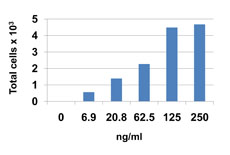- Regulatory Status
- RUO
- Other Names
- Interleukin-15 (IL-15), MGC9721
- Ave. Rating
- Submit a Review
- Product Citations
- publications
_100913.jpg&Width=240&Height=300&altFmImage_path=&Compression=90&Crop=5)
| Cat # | Size | Price | Quantity Check Availability | Save | ||
|---|---|---|---|---|---|---|
| 570309 | 4 pack | $94 | ||||
Interleukin-15 (IL-15) was discovered in supernatant from simian kidney epithelial cell line CV-1/EBNA, as a soluble factor capable of supporting proliferation of the IL-2-dependent cell line, CTLL-2 (1). IL-15 is a regulatory cytokine that is produced by dendritic cells, epithelial cells, human stromal cell line (IMTLH), fibroblasts, and monocytes (2). It plays an important role in immune response and shares many functions with IL-2, for example, it stimulates the proliferation of activated T cells (1, 2), NK cells (3) and B cells, and it induces immunoglobulin synthesis by B cells stimulated by anti-IgM or CD40 ligand (4). In addition, IL-15 promotes the development of dendritic cells (5), activates human neutrophils (6, 7) and induces the production of proinflammatory cytokines from macrophages (8). IL-15 acts as a bridge between innate and adaptive immunity because of its diverse roles in the immune system. IL-15 binds to heterotrimeric receptors composed of IL-15Rα, IL-15Rβ, and IL-15Rγc. IL-15 shares with IL-2 the receptor chains β and γc. IL-15 is normally not secreted in soluble form but is held on the cell surface bound to a unique receptor, IL-15Rα, especially on dendritic cells. Cell-bound IL-15 then is presented in trans to T cells and NK cells and is recognized by the γc receptor on these cells; such recognition maintains cell survival and intermittent proliferation (9).
Product DetailsProduct Details
- Source
- E. coli expressed protein
- Molecular Mass
- The 114 amino acid recombinant protein has a predicted molecular mass of 12.8 kD. The DTT-reduced protein migrates at approximately 9 kD and the non-reduced protein migrates at approximately 7 kD by SDS-PAGE. The N-terminal amino acid is Asn.
- Purity
- >98%, as determined by Coomassie stained SDS-PAGE.
- Formulation
- Lyophilized in sterile-filtered PBS, pH 7.2-7.4, containing 1% BSA, 0.09% sodium azide, and protease inhibitors.
- Concentration
- Lot-specific (to obtain lot-specific concentration and expiration, please enter the lot number in our Certificate of Analysis online tool.)
- Storage & Handling
- Unopened vials can be stored between 2°C and 8°C until the expiration date. Prior to use, reconstitute the lyophilized powder with 0.2 mL of PBS containing a carrier protein (e.g., 1% BSA, protease free), pH7.4. Re-cap vial, vortex. Allow the reconstituted standard to sit at room temperature for 15 minutes, vortex again to mix completely. The reconstituted standard stock solution can be aliquoted into polypropylene vials and stored at -70°C for up to one month. Do not re-use diluted standards. Avoid repeated freeze/thaw cycles.
- Application
-
ELISA - Quality tested
- Recommended Usage
-
Each lot of this protein is quality control tested by ELISA assay. For use as an ELISA standard, a standard curve comprised of doubling dilutions from 500 pg/ml to 7.8 pg/ml is suggested. It is recommended that the reagent be titrated for optimal performance for each application.
- Application Notes
-
This IL-15 protein is useful as a standard for a human IL-15 sandwich ELISA, using unlabelled BH1509 antibody (Cat. No. 515002) for capture and biotinylated BH1543 antibody (Cat. No. 515104) for detection.
Antigen Details
- Structure
- 13 kD single non-glycosylated polypeptide.
- Distribution
-
Adherent peripheral blood mononuclear cells, fibroblasts, and epithelial cells.
- Function
- IL-15 stimulates the proliferation of activated T cells, NK cells, and B cells, inducing immunoglobulin synthesis by B cells stimulated by anti-IgM or CD40 ligand. In addition, IL-15 promotes the development of dendritic cells, activates human neutrophils, and induces the production of proinflammatory cytokines from macrophages.
- Interaction
- T lymphocytes, NK cells
- Ligand/Receptor
- IL-15Rα, IL-15Rβ and IL-15γc.
- Cell Type
- B cells
- Biology Area
- Immunology, Innate Immunity, Stem Cells
- Molecular Family
- Cytokines/Chemokines
- Antigen References
-
1. Grabstein K, et al. 1994. Science 264:965.
2. Ma A, et al. 2006. Annu. Rev. Immunol. 24:657.
3. Meresse B, et al. 2004. Immunity 21:357.
4. Armitage RJ, et al. 1995. J. Immunol. 154:483.
5. Pulendran B, et al. 2004. Eur. J. Immunol. 34:66.
6. Bouchard A, et al. 2004. J. Leukoc. Biol. 76:162.
7. Ratthe C, et al. 2004. J. Leukoc. Biol. 75:893.
8. Feng T, et al. 2008. Cell Immunol. 5:189.
9. Rubinstein MP, et al. 2006. P. Natl. Acad. Sci. USA 103:9166. - Gene ID
- 3600 View all products for this Gene ID
- UniProt
- View information about IL-15 on UniProt.org
 Login/Register
Login/Register 



_100913.jpg&Height=80&altFmImage_path=&Compression=90&Crop=5)









_100913.jpg)





Follow Us